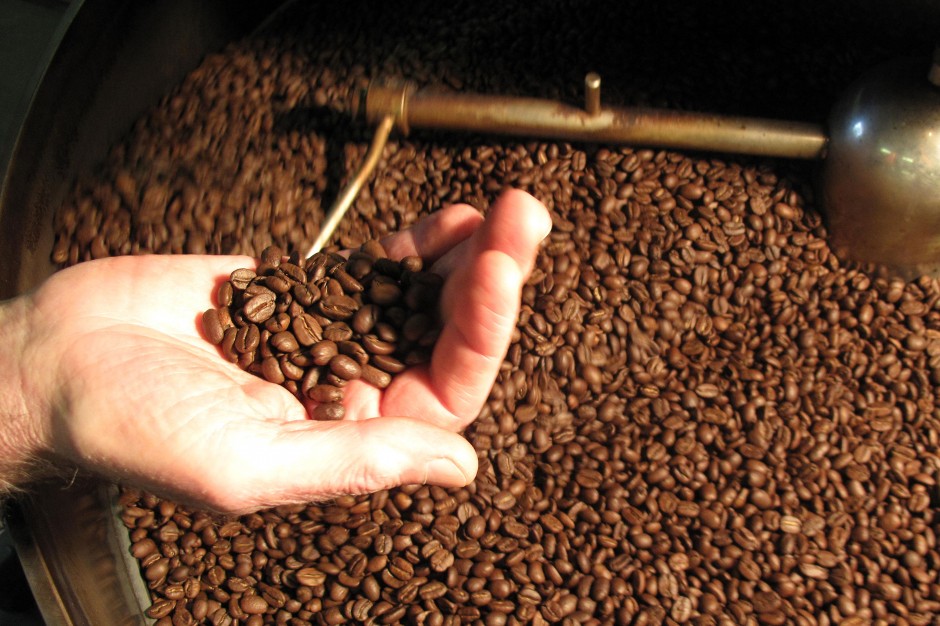The roasted coffee beans .
The roasted coffee beans (Coffee Roast) means bringing green coffee to heat or
steam pipes .
Roast the tank . Using temperatures from 120 to 300 degrees Celsius , which is
divided into the roasted coffee beans for 3 .
1 . The light roast (Light Roast).
Or also known as Cinnamon Roast , or Light Chololatetan.
Popcorn is the best light . The green coffee from a white or grayish green .
Changes to a medium brown . And no coffee oil sticks .
The roast will provide a high acidity and low intensity . Roasted like this .
Such as Blue Mountain, Mocca Coffee.
2. Central Roast (Medium Roast or C ity and Full City Roast).
Green coffee beans from a white or grayish green . A darker brown .
Than four cinnamon It will look like the coffee . It is a skin like satin .
But no oil sticks which include a roast of American Coffee,.
Irich Coffee, Java Coffee, Bracilian Coffee.
3. a dark roasted
(Dark Roast).
The darker the roast as the color of green coffee from a white or grayish green
.
Changes to chestnut Brown to black Coffee beans are oil sticks .
Throughout almost the whole coffee from coffee beans that are currently
available .
Such as Vienna Roast, Italian Roast (Espresso), French Roast.
Temperature 250-300 degrees Celsius .
Roasting brings out the aroma and flavor that is locked
inside the green coffee beans. Beans are stored green,
a state in which they can be kept without loss of
quality or taste. A green bean has none of the
characteristics of a roasted bean -- it’s soft and
spongy to the bite and smells grassy.
Roasting causes chemical changes to take place as the beans are rapidly brought
to very high temperatures. When they reach the peak of perfection, they are
quickly cooled to stop the process. Roasted beans smell like coffee, and weigh
less because the moisture has been roasted out. They are crunchy to the bite,
ready to be ground and brewed.
Once roasted, however, they should be used as quickly as possible before the
fresh roast flavor begins to diminish.
Roasting is both an art and a science
It takes years of training to become an expert roaster with the ability to
“read” the beans and make decisions with split-second timing. The difference
between perfectly roasted coffee and a ruined batch can be a matter of seconds.
Know your roasts
Most roasters have specialized names for their favored roasts and there is very
little industry standardization. This can cause some confusion when you’re
buying, but in general, roasts fall into one of four color categories — light,
medium, medium-dark and dark.
Many consumers assume that the strong, rich flavor of darker roasts indicates a higher
level of caffeine, but the truth is that light roasts actually have a
slightly higher concentration.
The perfect roast is a personal choice that is sometimes influenced by national
preference or geographic location. Within the four color categories, you are
likely to find common roasts as listed below. It’s a good idea to ask before you
buy. There can be a world of difference between roasts.
Light roasts
Light brown in color, this roast is generally preferred for milder coffee
varieties. There will be no oil on the surface of these beans because they are
not roasted long enough for the oils to break through to the surface.
-
Light City
-
Half City
-
Cinnamon
Medium roasts
This roast is medium brown in color with a stronger flavor and a non-oily
surface. It’s often referred to as the American roast because it is generally
preferred in the United States.
Medium dark roasts
Rich, dark color, this roast has some oil on the surface and with a slight
bittersweet aftertaste.
Dark roasts
This roast produces shiny black beans with an oily surface and a pronounced
bitterness. The darker the roast, the less acidity will be found in the coffee
beverage. Dark roast coffees run from slightly dark to charred, and the names
are often used interchangeably — be sure to check your beans before you buy
them!
-
High
-
Continental
-
New Orleans
-
European
-
Espresso
-
Viennese
-
Italian
-
French
 |
